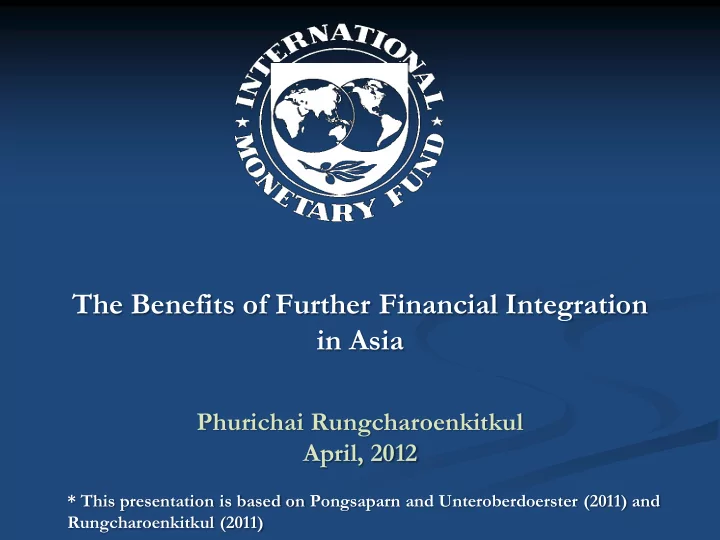

The Benefits of Further Financial Integration in Asia Phurichai Rungcharoenkitkul April, 2012 * This presentation is based on Pongsaparn and Unteroberdoerster (2011) and Rungcharoenkitkul (2011)
Questions What is the current degree of Asian financial integration? Can financial integration help Asia rebalance? What are the benefits and costs to each country, in terms of risk sharing and contagion? How to maximize the benefits of financial integration without raising the costs?
Quantity-based measures of financial integration Portfolio flows Inflows & Outflows x FDI flows f it , Assets & Liabilities Banking sector Z-score measure 3
The Degree of Financial Integration in Asia Outside financial centers, financial integration in Asia is limited: relative to world average relative to trade integration after controlling for standard push and pull factors both intra- and inter-regionally Z-score of Financial Integration Financial versus Trade Integration 4
A Catalyst for Rebalancing? Financial integration can foster rebalancing by: Inducing greater competition in banking sector, easing HH’s financing constraints Lowering liquidity premium in bond market and increasing investment (e.g. ABMI) Fostering financial innovation, lessening the need for precautionary savings 5
Financial Integration and CA Balances Augmented macro balance regression CA implications of closing integration gaps 6
Is There a Tradeoff to Financial Integration?
Red Cliff Battle Seeing the ships are all connected, Zhou Yu set the ships ablaze, Cao Cao chained his ships from stem to stern, to stabilize the fleet destroying the entire fleet. against waves and reduce seasickness in his navy. Will financial integration bring about ‘ risk-sharing ’ benefits that make up for the ‘contagion’ costs ? 8
Risk-sharing There is perfect risk sharing between 2 countries if all idiosyncratic risks are diversified Intuitively, consumption growth is equalized because shocks are shared (under some preferences) In asset pricing model, perfect risk sharing implies equality of the stochastic discount factors (SDFs) Brandt-Cochrane-SantaClara (2006) proposed a risk sharing metric: 9
Extracting SDFs Adopt price-based approach to extracting SDFs Stock market data do not suffice, need multidimensional bond prices Standard affine term structure model: State SDF Price of risk Short rate 10
SDFs East Asia (ex China) and Singapore US and EU Malaysia Philippines Thailand 11
BCS Matrix 12
Contagion Contagion is not correlation of asset prices Define contagion as ‘tail - event’ spillover in stock markets Tail correlation via quantile regression Contagion from j to i 13
Contag matrix 14
Is There a Tradeoff? • The US defines the efficient cost benefit frontier to integration for Asia • Most countries are less successful than the US in taking advantage of risk sharing, given the contagion costs incurred 15
Some Individual Countries Results Hong Kong SAR Singapore Korea Indonesia Malaysia Thailand 16
How to improve the terms of tradeoffs? More integration Better integration Context may include Greater integration leads to better integration (nonlinear 1. effect) Financial market developments 2. Size of economic shocks 3. Macroeconomic policy 4. 17
Quantifying the role of contextual factors 18
Concluding Remarks Making the most of financial integration requires a collective effort Getting it right would not only improve economic resilience, but also strengthen domestic sources of growth The way forward: More rather than less financial integration Harmonization of legal and institutional infrastructures Alignment of macroeconomic policy objectives
THANK YOU. 20
Recommend
More recommend